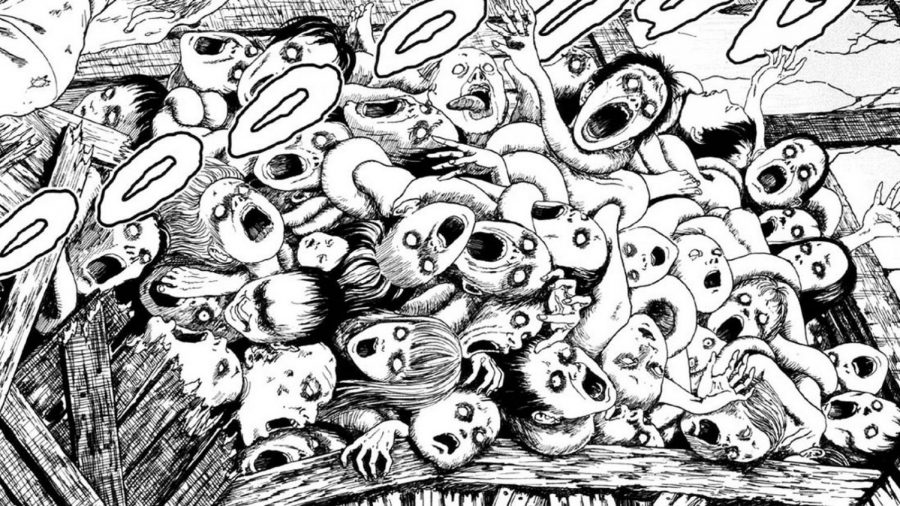For a Unique and Chilling Artistic Experience, Check Out Junji Ito
November 7, 2018
What first comes to mind when you think of horror? Is it ghosts? Demons? Creepy dolls? What about spirals? Grease? Ice cream? Surely there’s a disconnect between those two lists. After all, what could be scary about such mundane subjects as patterns and dessert? The answer lies in the works of Junji Ito, famed manga artist and horror manga revolutionary.
It’s important to understand what defines Japanese horror. In contrast to the modern horror we’re accustomed to in the West, Japanese horror doesn’t rely on cheap jump scares to spook the audience. Rather, it focuses on more psychological elements, often creating long, drawn out scenes that build a tense atmosphere. More often than not, Japanese horror will also use subtly terrifying creatures as a tool to achieve such an effect. Ito does that and much more.
The biggest thing that distinguishes Ito’s work from J-horror in general is his characters. Whereas in most J-horror works, the protagonist is the focal point of the story, Ito’s protagonists almost never are. In just about all of his stories, it’s the creature that is the focal point with the protagonists being almost unforgettable and taking a backseat to the horror on display. Take his short story “Used Record” for example. In the story, a mysterious jazz record transfixes any listener to the point where their obsession with the sound drives them to murder. The story’s protagonist, Nakayama, is practically indiscernible from any of his other protagonists, both in personality (or lack thereof) and appearance, but that’s the point. Ito knows that people aren’t reading for the characters; they’re reading for the threat.
When Ito’s protagonists are pushed to the side as much as they are, you can bet that his antagonists are truly haunting. Ito is notorious for creating incredibly morbid creatures and villains, often without clear motivations. Generally, they come in one of two forms: inexplicable phenomena or ceaseless obsession. The former is exemplified well in “The Long Dream,” a story in which a man’s dreams get increasingly longer by the night, feeling like days, then months, then years long. Spoiler alert: the cause of the long dreams is never revealed. In pieces like these, Ito clearly toys with the human fear of the unknown. We can be scared out of our wits of something, but we can rationalize it with a backstory. Ito never gives us that satisfaction, though. He simply leaves us with a visceral feeling of discomfort.
Similarly, obsession and compulsion frequently appear in Ito’s works. In those stories, the obsession itself is the villain, taking over the protagonist and driving them to the absolute extreme. In “Dissection Girl,” the antagonist is a girl obsessed with, you guessed it, dissection, going so far as pretending to be a cadaver so she can be dissected alive. Right off the bat, an obsession with dissection is strange, but Ito escalates it with what the obsession makes the protagonist do. Another short story, “Glyceride,” follows a young girl whose father is obsessed with grease, constantly forcing his son and daughter to drink it and letting it build up and soak the insides of the house. Grease on its own isn’t scary, but Ito uses this deranged obsession to twist our view of it. Ito’s works are incredible in how they prey on our familiarity with the things around us. What may normally be a menial part of our lives can become an unfathomable monster with the stroke of a pen.
Ito’s stories are certainly centered on psychological horror, but you can only be scared so much by a concept. What truly ties the horror together is Ito’s art. As you’ve likely already noticed from the above image, Ito’s style is unnatural. The characters are human, yes, but they’re strange-looking. They have bleach white faces with little to no shading and yet, in the panel from “Dissection Girl,” you see that the eyes are oddly detailed, creating a sunken, fear-inducing look. This is generally how Ito designs his characters; the protagonists are ordinary and flat, then, when the threat is introduced, his art becomes uncomfortable to look at. At this point, his characters dip into what is known as the uncanny valley. The uncanny valley exists on a slope that describes the relationship between how human-like a design is and how comfortable we are with it. The more human features we observe, the more comfortable we are, until the features hit an awkward in-between state in which they’re not quite human enough to be entirely realistic. That awkward point is the uncanny valley and Ito’s characters live in it.
On top of the discomforting aesthetic of his character design, Ito also implements body horror to get under the reader’s skin. In the same way he draws his eyes, his disfigured creatures are incredibly eerie and detailed. Ito’s most popular series, “Uzumaki”, for example, showcases intense amounts of body horror in vivid detail. For context, in “Uzumaki”, a small town is taken over by and becomes obsessed with spirals. The premise is almost comically harmless, but when you take a look at the story’s art it’s pretty disturbing. The stark contrast between his dull characters and these repulsive creatures is jarring. Just looking at them is unpleasant, but placed within the context of the whole story, they can be deeply unsettling.
All in all, Junji Ito’s stories are perfectly spine-chilling with how grotesque they are – both in plot and visuals. Despite the fact that his scenarios are rarely ever even remotely possible, they still manage to give us goosebumps and, on occasion, make us a little queasy. That’s the wonder of it all, though! Rather than giving us a spike of adrenaline with a jump scare, he forces us to fall back into the darkest recesses of our minds and discover fears we never even knew we had. Of course, this kind of horror isn’t for everyone. If it is, though, and if you have even the slightest interest in checking out Ito’s works, the ones previously mentioned are a great place to start! So, with that, I encourage you, like Junji Ito, to look closely and differently at the things around you. You never know, you might just end up discovering your deepest, darkest fear.











